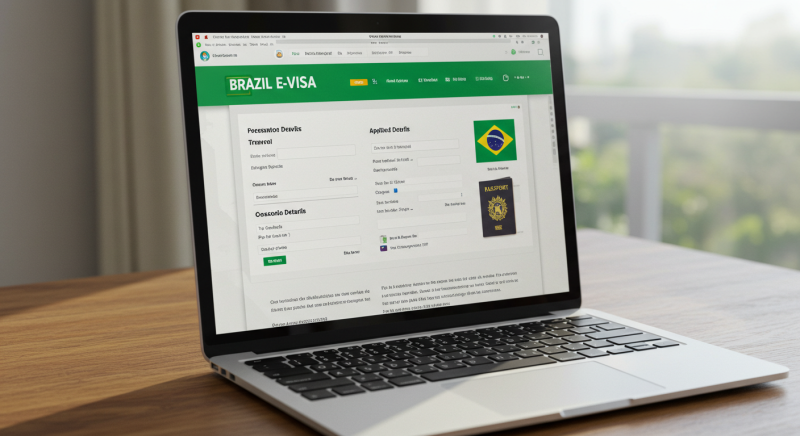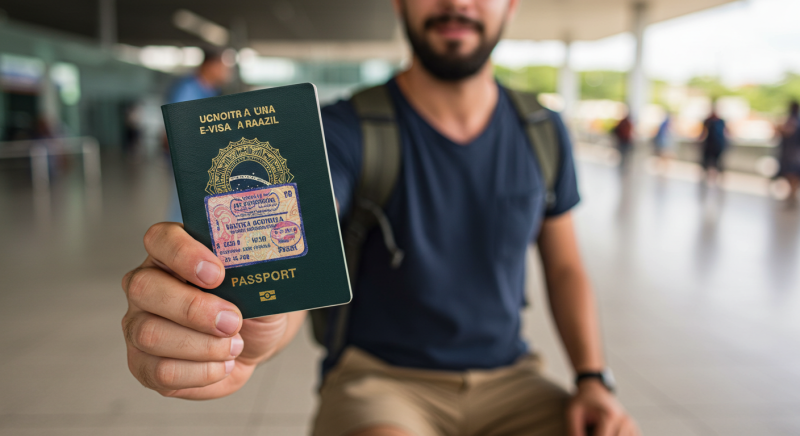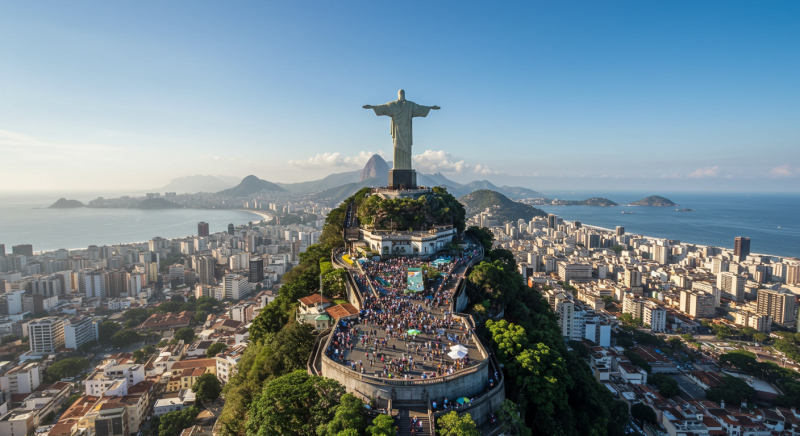Planning a trip to Brazil’s vibrant cities or lush rainforests? Wondering if you need a visa to enter the country? Starting April 10, 2025, the Brazilian government reinstated visa requirements for U.S. citizens—a policy shift that impacts tourists, business travelers, and even crew members. This guide breaks down the latest updates, application steps, and expert tips to ensure your Brazilian adventure goes smoothly.
Key Takeaways
- New Visa Policy: As of April 10, 2025, U.S. citizens must obtain a visa for tourism or business trips to Brazil.
- E-Visa Option: Apply online via Brazil’s official e-visa portal for a streamlined process.
- Validity & Cost: The visa costs $80.90, is valid for 10 years, and allows multiple entries.
- Special Cases: Minors and crew members have additional documentation requirements.
- Safety Tips: Stay informed about high-risk areas and travel advisories.

Understanding the Brazil Travel Visa Requirement
Brazil’s visa policies have shifted over the years, and staying informed about the latest rules is critical for travelers. Below, we explain the reasoning behind the reinstated visa mandate, who it affects, and how the updated system benefits visitors.
Why Did Brazil Bring Back Visa Requirements for U.S. Citizens?
In 2019, Brazil temporarily waived visas for travelers from the U.S., Canada, Australia, and Japan to boost tourism. However, this exemption ended in April 2025 when Brazil reintroduced visas for U.S. citizens. The change reflects a reciprocity policy: since the U.S. requires Brazilians to obtain visas for visits, Brazil now applies the same rule to Americans.
The decision aims to balance diplomatic relations while maintaining security. The new e-visa system, launched in 2023, simplifies applications and reduces processing times compared to traditional consular visas. According to Brazil’s Ministry of Foreign Affairs, over 90% of e-visa applications are approved within five days, minimizing delays for travelers.
Who Must Apply for a Brazil Travel Visa?
The visa requirement applies to all U.S. passport holders entering Brazil for:
- Tourism (e.g., visiting Rio de Janeiro, the Amazon, or Iguazu Falls).
- Business (attending conferences, meetings, or negotiating contracts).
- Family visits (staying with relatives or friends).
Exceptions include:
- Airline crew members on active duty, provided they arrive in uniform and carry valid crew IDs.
- Diplomats or officials with special authorization from Brazil’s government.
Children and infants are not exempt. Parents or guardians must apply for a separate e-visa for each minor and submit additional documents, such as birth certificates and notarized travel consent forms.
Key Features of the Brazil E-Visa
- 10-Year Validity: The e-visa allows multiple entries over a decade, making repeat trips hassle-free.
- 90-Day Stay Limit: Visitors can stay up to 90 days per entry, with one extension permitted per year through Brazil’s Federal Police.
- Digital Convenience: Applications are submitted online, and approved visas arrive via email—no in-person consulate visits required.
Brazil’s e-visa system has processed over 200,000 applications since 2023, with approval rates exceeding 95% for properly completed forms. This efficiency aligns with global trends, as countries like Australia and India have adopted similar digital visa systems to streamline tourism.
Common Misconceptions About the Visa Requirement
- Myth: “The visa is just a formality—approval is guaranteed.”
Reality: Applications can be denied for errors like passport expiration dates, insufficient funds, or incomplete itineraries. Double-check all details before submitting. - Myth: “I can adjust my travel dates after getting the visa.”
Reality: While the visa isn’t tied to specific dates, your passport must remain valid for at least six months beyond your entry date. Plan renewals early to avoid issues.
How the E-Visa Benefits Travelers
The e-visa system prioritizes speed and accessibility:
- 24/7 Applications: Submit forms anytime via the official portal.
- Real-Time Tracking: Monitor your application’s status using a reference number.
- Cost Savings: At 80.90,thee−visaischeaperthantraditionalvisas,whichpreviouslycostover160 and required mailed paperwork.
For frequent travelers, the 10-year validity is a major advantage. For example, a family planning annual vacations to Salvador’s Carnival or business travelers attending São Paulo’s tech conferences can use the same visa repeatedly.
Final Tips for Compliance
- Check Passport Expiry Dates: Renew your passport if it expires within six months of your trip.
- Print Multiple Visa Copies: Brazilian immigration may request physical proof during entry.
- Review Entry Rules: Some regions, like border areas with Venezuela or Paraguay, have restricted access for tourists due to safety concerns.
By understanding these requirements, you can avoid last-minute stress and focus on enjoying Brazil’s vibrant culture and natural beauty. For the latest updates, bookmark Brazil’s Ministry of Foreign Affairs visa page.

How to Apply for a Brazil E-Visa
Navigating the Brazil travel visa requirement is simpler than ever thanks to the country’s streamlined e-visa system. Here’s a step-by-step breakdown to help you secure your visa without confusion or delays:
Step 1: Prepare Your Documents
Start by collecting all necessary paperwork. Your passport must be valid for at least six months beyond your planned entry into Brazil and have two blank pages for immigration stamps. A recent passport-style photo is required—ensure it meets Brazil’s guidelines: a 2×2-inch size, white background, and neutral facial expression. Next, gather financial proof, such as bank statements from the last three months, to demonstrate you can cover your stay. Finally, secure a confirmed round-trip flight itinerary and hotel reservations or a signed letter from a host in Brazil.
Step 2: Access the Official E-Visa Portal
Visit Brazil’s government-approved e-visa website to begin your application. Avoid third-party platforms, as unofficial sites may charge unnecessary fees or provide outdated forms. The portal is available in English, Spanish, and Portuguese, with clear instructions for each field. Enter details like your full name, passport number, and travel dates exactly as they appear on your documents to prevent discrepancies.
Step 3: Review and Submit Your Application
Before finalizing, cross-check every entry for accuracy. Common errors—like typos in passport numbers or mismatched travel dates—are the top reasons for rejections. Once satisfied, submit the form and proceed to payment. The visa fee is $80.90, payable securely via credit or debit card. Save the transaction receipt for your records.
Step 4: Monitor Your Application Status
After submission, use the tracking number provided on the portal to check your application’s progress. Most e-visas are approved within five business days, but during peak travel seasons (e.g., Carnival or December holidays), processing can take up to two weeks. Avoid last-minute stress by applying at least 15 days before your trip.
Step 5: Receive and Print Your E-Visa
Approved visas are sent via email as a downloadable PDF. Print two copies: one to carry in your luggage and another to present at airport check-in and Brazilian immigration. Save a digital version on your phone as a backup. Double-check the visa’s validity dates and passport number to confirm they match your travel plans.
Pro Tips for Success
- Timing Matters: Submit your application early to account for holidays or technical delays.
- Avoid Common Errors: Triple-check passport numbers and expiration dates.
- Stay Updated: Bookmark Brazil’s e-visa portal for real-time policy changes.
By following these steps meticulously, you’ll meet the Brazil travel visa requirement efficiently, leaving you free to focus on planning your Amazon rainforest trek or Rio de Janeiro city tour.
For direct access to the application, visit the Brazil E-Visa Portal or contact the Brazilian consulate in your region for personalized support.
Special Considerations
Traveling with Minors
Brazil enforces strict rules for minors, including dual nationals. Children under 18 traveling without both parents need notarized authorization letters from absent parents, translated into Portuguese and apostilled. For dual citizens, an annotation in the Brazilian passport can replace these documents.
Safety and Entry Tips
- Avoid High-Risk Areas: Steer clear of informal settlements (favelas) and regions within 150 km of land borders due to crime.
- Health Declaration: Complete Brazil’s health form within 72 hours of departure.
- Public Transport: Exercise caution on buses, especially at night.
FAQ Section
1. Can I apply for a Brazil visa on arrival if I’m already in the country?
No, Brazil does not offer visas on arrival for U.S. citizens. All travelers must secure an approved e-visa before departing for Brazil. Immigration authorities will request proof of your visa during check-in at your departure airport and upon arrival in Brazil.
2. How long does the e-visa processing take?
Most applications are processed within five business days, but delays can occur during peak travel periods like Carnival or the December holidays. To avoid disruptions, submit your application at least 15 days before your trip. If urgent processing is needed, contact the Brazilian consulate directly for guidance.
3. Can I extend my stay beyond 90 days with an e-visa?
Yes, but only once per 12-month period. To extend your stay, visit a local Federal Police office in Brazil before your initial 90 days expire. You’ll need to provide a valid reason (e.g., medical care, family emergencies) and pay a fee. Overstaying without approval may result in fines or future entry bans.
4. What documents are required for minors applying for a Brazil e-visa?
Minors need the same e-visa as adults, plus additional documentation. If traveling without both parents, a notarized authorization letter from the absent parent(s) is mandatory. The letter must be translated into Portuguese and apostilled. For dual citizens, a Brazilian passport with an annotation confirming parental permission replaces this requirement.
5. Is the Brazil e-visa valid for multiple entries?
Yes. The e-visa allows multiple entries over its 10-year validity period, provided each stay does not exceed 90 days. This makes it ideal for frequent travelers, business professionals, or those planning multiple vacations in Brazil.
6. Do I need a visa for a layover in Brazil?
If your layover is less than 24 hours and you remain in the international transit area, a visa is not required. However, if you plan to leave the airport or your layover exceeds 24 hours, you must apply for an e-visa.
7. What happens if I lose my e-visa before traveling?
If you lose your e-visa, re-download the PDF from the confirmation email or the e-visa portal. If you no longer have access, contact the Brazilian consulate with your application reference number to request a reissued copy. Always carry both digital and printed backups.
8. Are there vaccination requirements to enter Brazil?
While no specific vaccines are mandatory for U.S. travelers, Brazil recommends vaccinations for yellow fever if visiting risk areas like the Amazon Basin. Check the CDC’s Brazil travel page for health advisories before departure.
9. Can I apply for a Brazil e-visa with dual citizenship?
Yes, but you must apply using the passport you intend to travel with. If you hold Brazilian citizenship, you’re required to enter and exit Brazil using your Brazilian passport, even if you have a second nationality.
10. What if my travel plans change after receiving the e-visa?
The e-visa is tied to your passport, not specific travel dates. As long as your passport remains valid and the visa’s 10-year validity period hasn’t expired, you can adjust your travel dates without reapplying. However, ensure your passport has enough blank pages for entry stamps.
11. Do I need to show proof of travel insurance?
Brazil does not require travel insurance for visa approval, but it’s strongly recommended. Insurance can cover medical emergencies, trip cancellations, or lost luggage—common issues in remote areas like the Pantanal or during busy festivals.
12. Can I use the e-visa for volunteer work or paid employment?
No. The e-visa is strictly for tourism, business meetings, or family visits. Paid work, internships, or volunteer roles require a different visa category. Contact the Brazilian consulate to apply for a work or residency visa.
13. How strict is the “six-month passport validity” rule?
Brazilian immigration enforces this rule rigorously. If your passport expires within six months of your arrival date, you’ll be denied entry. Renew your passport early if needed, as processing times for U.S. passport renewals can take 8–11 weeks.
14. Are digital copies of the e-visa accepted at entry points?
Yes, but it’s safer to carry a printed copy. Some rural airports or smaller immigration checkpoints may lack reliable technology to scan digital versions. Having both formats ensures a hassle-free entry.
15. What qualifies as “proof of financial means”?
Brazil accepts recent bank statements (last three months), credit card statements, or a signed letter from a sponsor. There’s no fixed minimum amount, but your funds should reasonably cover your planned stay. For a two-week trip, 1,500–2,000 is a common benchmark.

Conclusion
Navigating the Brazil travel visa requirement doesn’t have to be daunting. With the e-visa system’s efficiency and this guide’s insights, you’re well-prepared to explore Brazil’s iconic beaches, cultural festivals, and Amazonian wonders. Always double-check entry rules before traveling and stay updated via Brazil’s official visa website.
READ MORE
Comprehensive UK Visa Guide for Nigerian student
External Links
